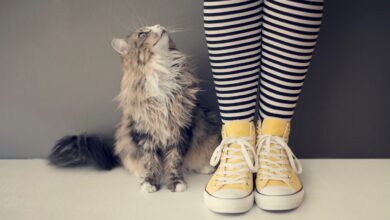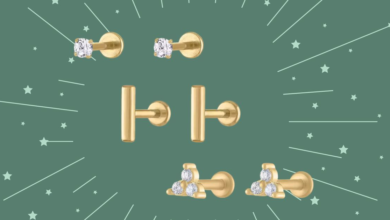Girl Power Was the Biggest Trend at New York Fashion Week

“Girl power, basically,” said Hillary Taymour, the designer of Collina Strada, backstage before her show at the start of New York Fashion Week. She wasn’t talking about bows and whistles; she was talking about the state of women in the world.
“I wanted to make a wardrobe to take on anything,” Ms. Taymour said, standing next to the actress Gina Gershon, who was wearing a long plaid coat with the sleeves puffed and smocked from shoulder to wrist. The coat made Ms. Gershon look like a Shakespearean gym bunny. She smirked and announced, “I feel baller in this.” She didn’t have to make a muscle; they were built in for her.
The whole Collina collection, including pastel floral latex shirts with sculpted abs and upcycled chiffon dresses with biceps and triceps quilted in, was a flex. Ms, Taymour even put a jacked model on the runway, perhaps the rarest sight on any catwalk.
The idea that women’s fashion might be about women’s power is so obvious that it risks seeming trite. But after seasons in thrall to discretion and femininity, at a time when women are having to battle for freedoms they once took for granted, clothing that centers unapologetic strength as a design principle is kind of thrilling. It was the biggest undercurrent in the New York shows.
The End of Naked Dressing
“Power,” Wes Gordon said before a Carolina Herrera show where he stripped away the froufrou to focus on construction: sharp shoulders, skirts with lines as clean as laboratory beakers, the clarity of black and white and red. “I think it’s very important that beauty and strength are not considered antonyms.”
“Power,” Michael Kors echoed. “Power suits.” That’s an old concept, but a photo of his grandparents’ 1930s wedding led him to redefine it by layering cashmere hoodies and lace slip dresses under double-breasted jackets, so the contrast did the heavy lifting.
“Strength, independence,” Gabriela Hearst recited. She was describing the painter Leonora Carrington, her muse of the season, who happened to be one of the founders of the women’s liberation movement in Mexico and whose Surrealist bent inspired Ms. Hearst to mess with material. Her lace was actually knit from cashmere; her denim made from recycled cotton and hemp.
The era of naked dressing appears to be over. In its place are clothes that, as Peter Do wrote in the notes for his sophomore Helmut Lang show, don’t only “protect us” but “project us.” (The idea was right on, though the execution was not as convincing. Mr. Do is still tripping over the Lang legacy.) Mike Eckhaus and Zoe Latta put it this way in their very good Eckhaus Latta show: “You are a logo” — all on your own.
In their hands that meant addictively atonal patchworks of stretch lace and glimmering knits, slouchy wide-wale cords and big faux-fur coats. In others, it meant garments that asserted their right to take up space.
See sweeping leather trenches and throwaway deb skirts at Coach; bristling tinsel coats and leather skirts that looked like unfolded origami at Tory Burch; boss-lady overcoats with detachable scarves that weaponize the neck at Proenza Schouler. There were even basic wools given the curves of an opera coat at Fforme, where Paul Helbers drapes so subtly you don’t even realize that what looks like a caftan is actually a batwing gown until the arms unfurl and it takes flight.
Some Red Meat
Maybe that’s why Elena Velez decided that rather than stage a traditional catwalk show, it was time to host a “salon” featuring a discussion between the podcasters and cultural commentators Anna Khachiyan of “Red Scare” and Jack Mason of “The Perfume Nationalist,” on the subject of Scarlett O’Hara and “Gone with the Wind.” To accessorize the event, she had a few models (and Ms. Khachiyan) walking around in Tara corsetry and sweeping skirts, in a sort of text-to-trends scenario.
The point was to use fashion as a lubricant for substantive discussion, she said when welcoming people to her event. But while the premise promised controversy, it served up mostly faux transgression, avoiding the most problematic aspects of the book (its celebration of the confederacy; the role of slavery) in favor of performatively provocative statements about female agency.
The truth is, if Ms. Velez had simply let her clothes, which elevate off-cuts — fabric scraps that would otherwise be thrown away — in glossy silk and budget acetate to a high art and effectively shredded antebellum orthodoxies, do the talking for her, the result would have been more convincing. After all, that’s the promise of fashion: to allow people the liberty to excerpt it, and wield it, in any way they see fit.
To flip the narrative, as Joseph Altuzarra did in his 15th-anniversary show, held in his offices like a meet-and-greet. In underplaying the grandeur, it overscored on the individual. The Pierrot ruffles, soft ribbed jodhpurs and jet-beaded tuxedo shirt were seemingly made for women who lunch. On steak tartare.
A New Story
When it comes to eating the scenery, however, no one makes a point more theatrically than Thom Browne, who used Edgar Allan Poe’s “The Raven” as his source material but then handed the authorial reins to a woman.
To be specific, Carrie Coon of “The Gilded Age,” whose voice-over recitation formed the soundtrack to a show set in a dark and desolate scene, with a mountainous black coat tree (literally, a man trapped in an ebony coat with skeletal branches for hands and atop his head) at its center.
Black snow fell on white ground as ravens (or, to be clear, raven-representing models) appeared in evermore elaborate constructions of black and white tweeds, leathers and tulle. Atop a base of black sheath dresses, coats and jackets were wrenched off the shoulder and blossomed over the hips in a New Look-on-steroids silhouette; exaggerated Poiret dresses ballooned to the calves; and intarsia ravens and roses were scattered over it all.
At the end, Ms. Coon shrieked the poem’s famous line in increasingly hysterical tones: “Nevermore. Nevermore,” and so on and on. Like the clothes, she was wonderfully impossible to ignore.




